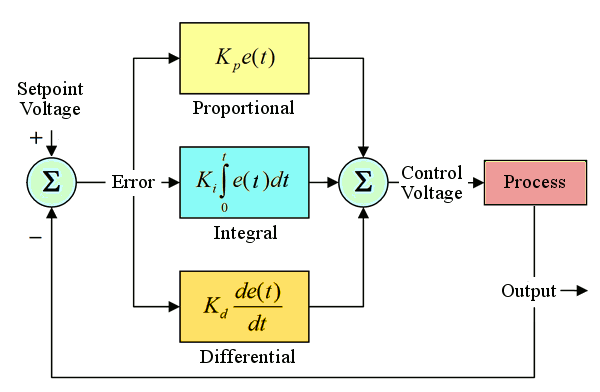This post is a brief recap of an article written by Eric Utterson, President of 8760 Engineering, that was published in March 2003 publication of the ASHRAE Journal.
This article addresses a method for achieving predictable linear response for
supply duct pressure control, economizer damper control and steam heat
exchanger leaving water temperature control using PID control loops.
Some background of PID loops may help understand why PID control loops are important to energy efficiency. At a high level, feedback controllers attempt to minimize the error between a setpoint, say discharge air temperature setpoint, and a measured process variable, such as actual discharge air temperature. The controller will compare the actual temperature versus the desired temperature and adjust some process control input, such as the chilled water control valve, to minimize the error. PID controllers allow systems more closely track their setpoints and achieve the efficiencies an engineer has specified. If an engineer sets the discharge air temperature at 60° F in the middle of winter, a properly tuned PID loop controller will achieve this setpoint instead of operating at the 55° F summer setpoint (thus saving energy back at the chiller plant and at the reheat box).
A proportional-integral-derivative controller (PID
controller) uses three separate constant parameters in the algorithm that can
be interpreted with respect to time: P (proportional) depends on the present
error, I (integral) depend on the accumulation of past errors, and D
(derivative) is a prediction of future errors, based on current rate of change. In the simplest form, the output of a PID
loop is described as:
PIDOutput = Pgain × (Error+ 1/Itime × ∫ 〖Error ×dt〗+Dtime × dError/dt)
where:
Error = PID Input – PID Setpoint (for
direct acting control scenarios)
Pgain = Proportional Gain Term
Itime = Integral Time
Dtime = Derivative Time
Supply Duct Pressure
Control
The goal of the linearization process is
to create PID input and setpoint equations that describe the controlled process
and compensate for all known varying inputs.
For supply duct pressure control, the final linearized equation must
apply for any given supply airflow rate, supply duct pressure loss coefficient
and supply fan speed (equations are shown in the paper). Thus, we can establish the following
equations for PIDsetpoing and PIDinput:
PIDsetpoint = FanSpeed_sp = FanSpeed × √((∆P_sp)/∆P)
PIDinput = FanSpeed
Economizer Damper
Control
Similar to the supply duct pressure
control linearization method described above, the goal of the economizer damper
linearization process is to calculate a PID input equation and PID setpoint
equation so that each compensates for the known nonlinearities. For economizer damper control, the following equations
can be used:
PIDsetpoint = %OA_sp ≈ 100% × ((RAT - DAT_sp) / (RAT - OAT))
PIDinput = %OA ≈ 100% × ((RAT - DAT) / (RAT - OAT))
Steam Heat Exchanger
Leaving Water Temperature
Linearization of the steam heat exchanger
system requires measurement of either water flow rate or entering water
temperature. Because obtaining the water
temperature is less expensive and more reliable, the following linearization
method addresses the case where the entering water temperature is known. The fundamental equations for water flow are
detailed in the paper; this post showcases resulting PID equations:
PIDsetpoint = %Q_sp = %Q × ((LWT_sp - EWT) / (LWT - EWT))
PIDinput = %Q ≈ SteamValvePosition
All of these equations can be used to the
benefit of energy savings by allowing the engineer to specify energy saving
setpoints.
As usual, we end with a typical energy conservation measure that is all too often over looked, having parking garage exhaust fans tied into a CO monitor. This system runs the fan only when the CO levels reach certain levels and greatly reduces the run time of exhaust fans.
ECM: Parking Garage CO Ventilation
Average kWh Saved per Sq. Ft.: 2.25
Article Author: Eric Utterson
eutterson@8760engineering.com
Blog Post Author: Ryan Corrigan
ECM: Parking Garage CO Ventilation
Average kWh Saved per Sq. Ft.: 2.25
Article Author: Eric Utterson
eutterson@8760engineering.com
Blog Post Author: Ryan Corrigan

